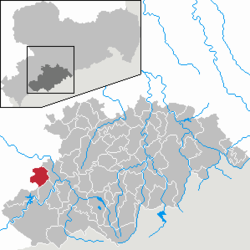Schneeberg (Ore Mountains)
| Schneeberg | ||
|---|---|---|
 |
||
|
||
| Coordinates: 50°35′39″N 12°38′44″E / 50.59417°N 12.64556°ECoordinates: 50°35′39″N 12°38′44″E / 50.59417°N 12.64556°E | ||
| Country | Germany | |
| State | Saxony | |
| District | Erzgebirgskreis | |
| Government | ||
| • Mayor | Frieder Stimpel (CDU) | |
| Area | ||
| • Total | 23.35 km2 (9.02 sq mi) | |
| Elevation | 470 m (1,540 ft) | |
| Population (2015-12-31) | ||
| • Total | 14,732 | |
| • Density | 630/km2 (1,600/sq mi) | |
| Time zone | CET/CEST (UTC+1/+2) | |
| Postal codes | 08289 | |
| Dialling codes | 03772 | |
| Vehicle registration | ERZ, ANA, ASZ, AU, MAB, MEK, STL, SZB, ZP | |
| Website | www.schneeberg.de | |
Schneeberg is a town in Saxony’s district of Erzgebirgskreis. It has roughly 16,400 inhabitants and belongs to the Town League of Silberberg (Städtebund Silberberg). It lies 4 km west of Aue, and 17 kilometres (11 mi) southeast of Zwickau.
Schneeberg lies on the Silver Road in the upper western Ore Mountains. Visible from afar is the prominent church of St. Wolfgang. The heart of the town lies on the Schneeberg, which reaches 470 metres above sea level and is also the town’s namesake. Among the surrounding peaks are the Gleesberg (593 m) to the east and the Keilberg (557 m) to the north.
Schneeberg’s more than 500-year-long history has been shaped by mining more than anything else, laying the very groundwork for the town’s founding. The original silver mining also yielded cobalt and bismuth mining by the mid 16th century. When uranium mining was being undertaken between 1946 and 1958, the town’s population quickly rose, leading to Schneeberg’s status as a district-free town (kreisfreie Stadt) between 1952 and 1958. Afterwards it once again belonged to the district of Aue.
Development of population figures (as of 1960 on 31 December):
129 October
231 August
The St. Wolfgangskirche is one of the biggest and architecturally most mature churches built in the Late Gothic style, and is an earlier type of Reformation church construction. Inside are found works by Lucas Cranach the Elder and the Crodel family of painters, whom the Krodel-Brunnen (fountain), demolished in late 2005, commemorated.
Among the other sights to be seen are the neo-Gothic Town Hall, newly built in the mid 19th century, various Baroque buildings and mining memorials.
...
Wikipedia



